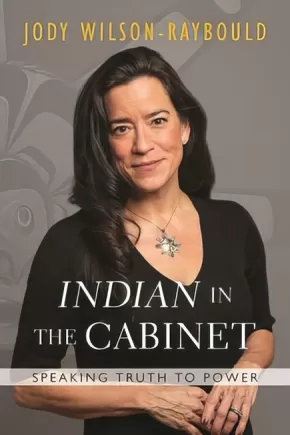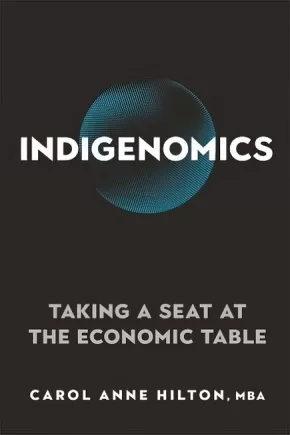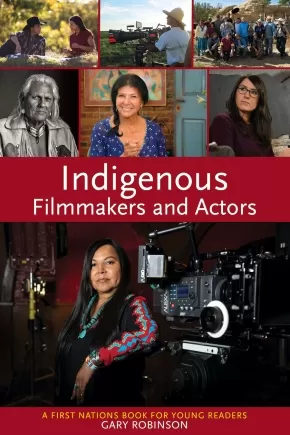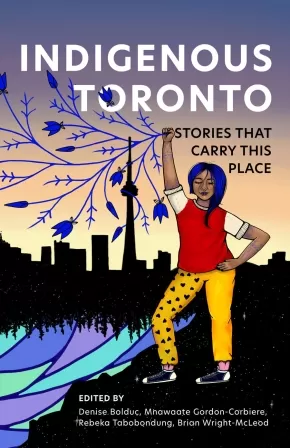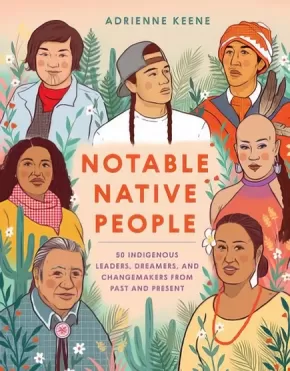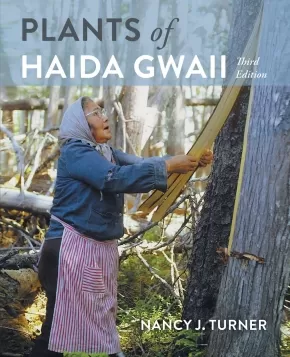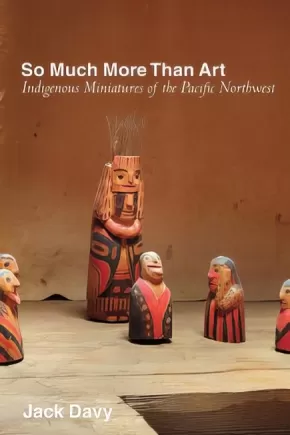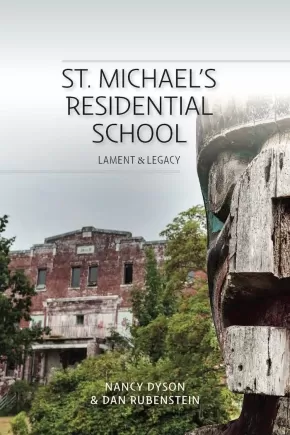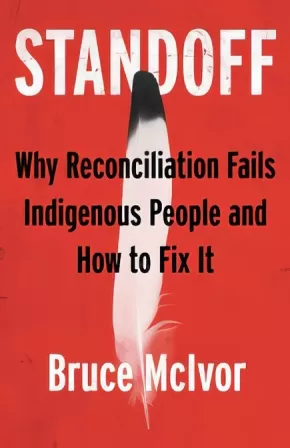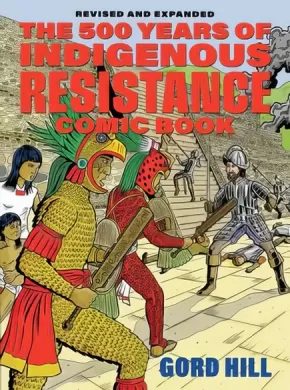
Social Studies
106
-
120
of
278 Results;
Sort By
Go To
of 19
Indian in the Cabinet: Speaking Truth to Power
$34.99
Format:
Hardcover
Text Content Territories:
Indigenous Canadian; First Nations; Kwakwaka'wakw (Kwakiutl); Musgamagw Tsawataineuk; Ligwilda'wx (Laich-kwil-tach); We Wai Kai Nation;
Reading Level: N/A
ISBN / Barcode: 9781443465366
Synopsis:
Synopsis:
A compelling political memoir of leadership and speaking truth to power by one of the most inspiring women of her generation.
Jody Wilson-Raybould was raised to be a leader. Inspired by the example of her grandmother, who persevered throughout her life to keep alive the governing traditions of her people, and raised as the daughter of a hereditary chief and Indigenous leader, Wilson-Raybould always knew she would take on leadership roles and responsibilities. She never anticipated, however, that those roles would lead to a journey from her home community of We Wai Kai in British Columbia to Ottawa as Canada’s first Indigenous Minister of Justice and Attorney General in the Cabinet of then newly elected prime minister, Justin Trudeau.
Wilson-Raybould’s experience in Trudeau’s Cabinet reveals important lessons about how we must continue to strengthen our political institutions and culture, and the changes we must make to meet challenges such as racial justice and climate change. As her initial optimism about the possibilities of enacting change while in Cabinet shifted to struggles over inclusivity, deficiencies of political will, and concerns about adherence to core principles of our democracy, Wilson-Raybould stood on principle and, ultimately, resigned. In standing her personal and professional ground and telling the truth in front of the nation, Wilson-Raybould demonstrated the need for greater independence and less partisanship in how we govern.
"Indian” in the Cabinet: Speaking Truth to Power is the story of why Wilson-Raybould got into federal politics, her experience as an Indigenous leader sitting around the Cabinet table, her proudest achievements, the very public SNC-Lavalin affair, and how she got out and moved forward. Now sitting as an Independent Member in Parliament, Wilson-Raybould believes there is a better way to govern and a better way for politics—one that will make a better country for all.
Additional Information
352 pages | 6.00" x 9.00" | Hardcover
Indigenomics: Taking a Seat at the Economic Table
$24.99
Format:
Paperback
Text Content Territories:
Indigenous Canadian;
Grade Levels: University/College;
ISBN / Barcode: 9780865719408
Synopsis:
Synopsis:
Igniting the $100 billion Indigenous economy
It is time. It is time to increase the visibility, role, and responsibility of the emerging modern Indigenous economy and the people involved. This is the foundation for economic reconciliation. This is Indigenomics.
Indigenomics lays out the tenets of the emerging Indigenous economy, built around relationships, multigenerational stewardship of resources, and care for all. Highlights include:
- The ongoing power shift and rise of the modern Indigenous economy
- Voices of leading Indigenous business leaders
- The unfolding story in the law courts that is testing Canada's relationship with Indigenous peoples
- Exposure of the false media narrative of Indigenous dependency
- A new narrative, rooted in the reality on the ground, that Indigenous peoples are economic powerhouses
- On the ground examples of the emerging Indigenous economy.
Indigenomics calls for a new model of development, one that advances Indigenous self-determination, collective well-being, and reconciliation. This is vital reading for business leaders and entrepreneurs, Indigenous organizations and nations, governments and policymakers, and economists.
Awards
- 2022 First Nations Community Reads Award
Educator Information
This book is centered within the United Nations Declaration on the Rights of Indigenous Peoples (UNDRIP).
Indigenomics is a new topic and a previously unpublished contribution to new economic thought.
This book is an important work in the emerging modern Indigenous economy. It is a guide to fully realizing the potential of the emerging Indigenous economy. It lays out the emerging power shift and rise of Indigenous economic empowerment. It acknowledges the unfolding story shaping Canada through the law courts that is testing the foundation of the Crown relationship with Indigenous peoples.
Includes interviews with six business leaders, all exceptional in their field.
Additional Information
272 pages | 6.00" x 9.00" | 20 b&w illustrations
Indigenous Filmmakers and Actors
$10.95
Format:
Paperback
Text Content Territories:
Indigenous Canadian; Indigenous American;
ISBN / Barcode: 9781772601725
Synopsis:
Synopsis:
In these entertaining profiles, twelve Indigenous actors and filmmakers tell stories of the hard work and struggle that went into their careers. Overcoming prejudice and stereotypes in the film industry, fighting to make and promote films that demonstrate an honest portrayal of Indigenous life and heritage. Their stories show how there’s more to filmmaking than acting and directing, including writing, producing, editing, designing, and special effects.
Their accomplishments include acting in major blockbuster films and TV shows, directing prize-winning documentaries, running film programs, and starting a film festival to promote Indigenous voices. These twelve have stood on the shoulders of the Indigenous filmmakers who came before them, and are working to open doors for the next generation. They encourage young people to pursue their dream, and that their stories and ideas are valuable. Includes Tantoo Cardinal, Alanis Obomsawin, and Doreen Manuel.
Educator & Series Information
This book is part of the First Nations Series for Young Readers. Each book is a collection of biographies of First Nations, Métis, and Inuit women and men who are leaders in their fields of work, in their art, and in their communities.
Recommended for ages 9-14.
Subjects:
Language Arts
> Biography
Reflecting Diversity
> First Nations & Indigenous Peoples
Additional Information
128 pages | 6.00" x 9.00"
Indigenous Toronto: Stories that Carry This Place
$24.95
Editors:
● Denise Bolduc (Indigenous Canadian; First Nations; Anishinaabeg; Ojibway; Batchewana;)
● Mnawaate Gordon-Corbiere (Indigenous Canadian; First Nations; Anishinaabeg; Ojibway; M'Chigeeng First Nation;)
● Rebeka Tabobondung (Indigenous Canadian; First Nations; Anishinaabeg; Wasauksing First Nation;)
 Show More ...
Show More ...
● Mnawaate Gordon-Corbiere (Indigenous Canadian; First Nations; Anishinaabeg; Ojibway; M'Chigeeng First Nation;)
● Rebeka Tabobondung (Indigenous Canadian; First Nations; Anishinaabeg; Wasauksing First Nation;)
Format:
Paperback
Text Content Territories:
Indigenous Canadian; First Nations; Anishinaabeg; Haudenosaunee (Iroquois); Huron-Wendat (Ouendat);
ISBN / Barcode: 9781552454152
Synopsis:
Synopsis:
A collection of perspectives by and about Indigenous Toronto, past, present, and future.
Beneath every major city in North America lies a deep and rich Indigenous history that has been colonized, paved over, and ignored. Few of its current inhabitants know that Toronto has seen 12,000 years of different peoples, including the Haudenosaunee, the Anishinaabe, the Huron-Wendat, and the Mississaugas of the New Credit, and a vibrant culture and history that thrives to this day.
With original contributions by Indigenous elders, scholars, journalists, artists, activists, and historians about art, food, health, and more, this unique anthology explores the poles of erasure and cultural continuity that have come to define a crossroads city-region that was known as a meeting place long before the arrival of European settlers.
Contributors include political scientist Hayden King, historian Alan Corbiere, musician Elaine Bomberry, artist Duke Redbird, playwright Drew Hayden Taylor, educator Kerry Potts, writer/journalist Paul Seesequasis and former Mississaugas of the New Credit chief Carolyn King.
Additional Information
192 pages | 5.50" x 8.50"
Notable Native People: 50 Indigenous Leaders, Dreamers, and Changemakers from Past and Present
$24.99
Artists:
Format:
Hardcover
Text Content Territories:
Indigenous American; Alaska Native; Native American; Indigenous Hawaiian;
ISBN / Barcode: 9781984857941
Synopsis:
Synopsis:
An accessible and educational illustrated book profiling 50 notable American Indian, Alaska Native, and Native Hawaiian people, from NBA star Kyrie Irving of the Standing Rock Lakota to Wilma Mankiller, the first female principal chief of the Cherokee Nation
Celebrate the lives, stories, and contributions of Indigenous artists, activists, scientists, athletes, and other changemakers in this beautifully illustrated collection. From luminaries of the past, like nineteenth-century sculptor Edmonia Lewis—the first Black and Native American female artist to achieve international fame—to contemporary figures like linguist jessie little doe baird, who revived the Wampanoag language, Notable Native People highlights the vital impact Indigenous dreamers and leaders have made on the world.
This powerful and informative collection also offers accessible primers on important Indigenous issues, from the legacy of colonialism and cultural appropriation to food sovereignty, land and water rights, and more. An indispensable read for people of all backgrounds seeking to learn about Native American heritage, histories, and cultures, Notable Native People will educate and inspire readers of all ages.
Additional Information
144 pages | 7.26" x 9.29" | Hardcover
Orange Shirt Day Book Package
$92.99
Artists:
Text Content Territories:
Indigenous Canadian; First Nations; Salish; Interior Salish; Secwepemc (Shuswap); Stswecem'c Xgat'tem;
ISBN / Barcode: 9781989122808
Synopsis:
Synopsis:
A collection of authentic Orange Shirt Day books from the founder of the Orange Shirt Day movement, Phyllis Webstad. Package includes four books and three accompanying lesson plans, The Orange Shirt Story, Phyllis's Orange Shirt, Orange Shirt Day and Beyond the Orange Shirt Story.
Educator Information
Includes picture books for children, as well as books for young adults. Review individual titles for more information about each include:
Additional Information
9.00" x 12.00"
Plants of Haida Gwaii: Third Edition
$29.95
Format:
Paperback
Text Content Territories:
Indigenous Canadian; First Nations; Haida;
ISBN / Barcode: 9781550179149
Synopsis:
Synopsis:
For many thousands of years the lands and waters of Haida Gwaii have been home to the Haida. Plants of Haida Gwaii, written with the cooperation and collaboration of Haida knowledge holders and botanical experts, is a detailed and insightful record of the traditional uses of over 150 species of native plants. Moreover, it explains the systems of knowledge and understanding that enabled the Haida to use the resources of their islands sustainably from one generation to the next over millennia.
The Haida names of these plants indicate their importance, as do the many narratives featuring them. From the ts’uu—massive western red-cedars—of the forests which provide wood used for canoes, house posts, poles and boxes, and bark carefully harvested for weaving mats, baskets and hats, to the ngaal—tough, resilient fronds of giant kelp—used to harvest herring eggs, the botanical species used by the Haida are found from the ocean to the mountain tops, and are as important today as ever before. With over 250 photographs and illustrations, this book is both beautiful and informative.
Additional Information
272 pages | 7.50" x 9.25"
Authenticity Note: As there are contributions from Haida knowledge holders, this work has been labelled as containing authentic Indigenous text. It is up to readers to determine if this work is authentic for their purposes.
Righting Canada's Wrongs: Residential Schools: The Devastating Impact on Canada's Indigenous Peoples and the Truth and Reconciliation Commission's Findings and Calls for Action (PB) - 2nd Edition
$29.95
Format:
Paperback
Text Content Territories:
Indigenous Canadian; First Nations; Inuit; Métis;
ISBN / Barcode: 9781459416918
Synopsis:
Synopsis:
Over more than 100 years, the Canadian government took 150,000 First Nations, Métis, and Inuit children from their families and placed them in residential schools. In these schools, young people were assigned a number, forced to wear European-style clothes, forbidden to speak their native language, required to work, and often subjected to physical and psychological abuse. If they tried to leave the schools to return to their families, they were captured by the RCMP and forced back. Run by churches, the schools were paid for by the federal government. The last residential school closed in 1996.
It took decades for people to speak out in public about the devastating impact of residential schools. School Survivors eventually came together and launched court actions against the federal government and the churches. In 2008 the Canadian government apologized for the historic wrongs committed by the residential school system. The survivors’ lawsuits led to the Indian Residential Schools Settlement Agreement, the largest class-action settlement in Canadian history, and the establishment of the Truth and Reconciliation Commission. The Commission spent six years gathering testimony and discovering the facts about residential schools.
This book includes the text of the government’s apology and summarizes the Truth and Reconciliation Commission’s 94 Calls to Action, which offer the basis for a new relationship between the Canadian government, Indigenous people and non-Indigenous people.
Reviews
"If I were purchasing materials for a high school library, I would buy at least 2 copies, and I would urge Social Studies and Aboriginal Studies classroom teachers to have at least one copy on their bookselves. Perhaps the strongest work to date in the Righting Canada's Wrongs series, Residential Schools underscores the importance of the Truth and Reconciliation Commission's work... Highly Recommended." — CM: Canadian Review of Materials
Educator & Series Information
This book is part of the Righting Canada's Wrongs series.
Recommended for ages 13 to 18.
This book is available in French: Les pensionnats indiens: Effets dévastateurs sur les peuples autochtones du Canada et appels à l'action de la Commission de vérité et réconciliation.
Additional Information
128 pages | 8.50" x 11.53" | Paperback | 2nd, Updated Edition
Righting Canada's Wrongs: The LGBT Purge and the Fight for Equal Rights in Canada
$34.95
Format:
Hardcover
ISBN / Barcode: 9781459416192
Synopsis:
Synopsis:
From the 1950s to 1980s, the Canadian government persecuted LGBTQ+ employees and tried to erase them from the military, the RCMP and the civil service under the guise that they were a “security risk,” an event that became known as the LGBT Purge. Those who were suspected of being homosexual were put under government surveillance, interrogated and intimidated. They were fired from their jobs. Many quit to avoid being exposed. Some committed suicide as a result. In the 1980s, victims of the Purge fought back with a class-action suit against the government that helped shed light on the systemic discrimination that members of the LGBTQ+ community faced from the government and the rest of society. In 2017, the federal government issued a formal apology on behalf of the government and Canadian society for the treatment of members of the LGBTQ+ community.
In this highly visual book, author Ken Setterington presents the struggle for LGBTQ+ rights using photographs, first-person accounts and excerpts from archival documents. Significant events in the struggle include the establishment of Pride parades, the Bathhouse Raids, the decriminalization of homosexuality, the passing of the Canadian Charter of Rights and Freedoms, the LGBT Purge and the legalization of same-sex marriage.
While the government’s formal acknowledgement of past injustices started Canada on a better path toward equality, there is still work to be done. This book would be a welcome addition to any classroom or library’s social justice collection and will appeal to adults interested in LGBTQ+ rights in Canada.
Educator & Series Information
Recommended for ages 13 to 18.
The Righting Canada's Wrongs series is devoted to the exploration of the mostly unknown, and often shocking, stories of Canadian government's racist actions against various ethnic groups through our history, the fight for acknowledgment and justice, and the eventual apologies and restitution of subsequent governments.
Additional Information
96 pages | 9.01" x 11.02" | 300 photographs | Hardcover
sînapân kîskasâkâs: A Guide to Making Contemporary-Style Métis Ribbon Skirts
$24.95
Format:
Paperback
Text Content Territories:
Indigenous Canadian; Métis;
ISBN / Barcode: 9781926795966
Synopsis:
Synopsis:
sînapân kîskasâkâs: A Guide to Making Contemporary-Style Métis Ribbon Skirts will assist you in the creation of your own Métis style ribbon skirt. Authors, Bonny Johnson and Leah Marie Dorion guide you through the process with detailed instructions which are accompanied by photographs of each step. This resource comes with a companion DVD, and introductions from both authors on the historical and contemporary uses of these traditional Métis style ribbon skirts.
Educator Information
Grade Level: Secondary, Post Secondary, Adult
So Much More Than Art: Indigenous Miniatures of the Pacific Northwest
$89.95
Format:
Hardcover
Text Content Territories:
Indigenous Canadian;
ISBN / Barcode: 9780774866552
Synopsis:
Synopsis:
Miniature canoes, houses and totems, and human figurines have been produced on the Northwest Coast since at least the sixteenth century. What motivates Indigenous artists to produce these tiny artworks? Are they curios, toys, art, or something else?
So Much More Than Art is an original exploration of this intricate cultural pursuit. Through case studies and conversations with contemporary Indigenous artists, Jack Davy uncovers the ways in which miniaturization has functioned as a subtle form of communication and, since contact, resistance in the face of aggressive colonization. His interviewees dismiss the persistent assertion running through studies of material culture that miniatures were no more than toys for children or souvenir trinkets. They are in fact crucial components of satirical opposition to colonial government, preservation of traditional techniques, and political and legal negotiation.
This nuanced study of a hitherto misunderstood practice convincingly demonstrates the importance of miniaturization as a technique for communicating complex cultural ideas between generations and communities, and across the divide that separates Indigenous and settler societies. So Much More Than Art is also a testament to the resilience of the Indigenous peoples of the Northwest Coast.
Students and scholars of anthropology, museum studies, Indigenous studies, and art history will find this work a valuable addition to their libraries, as will museum, arts, and heritage professionals.
Reviews
"So Much More Than Art goes beyond other studies by demonstrating how Northwest Coast Indigenous artists use and have used miniaturization not only as an artistic practice but in provoking interventions in social relations and as a strategy of communication and resistance in the face of colonialism." — Karen Duffek, curator, Contemporary Visual Arts and Pacific Northwest, Museum of Anthropology at UBC
"Drawing heavily on the knowledge and opinions of Indigenous experts from communities all along the coast, Jack Davy invites us to think more critically about Northwest Coast miniatures, and leaves us with a framework with which to do so." — Kaitlin McCormick, curator, Western Ethnology, Canadian Museum of History
Educator Information
Table of Contents
Introduction
1 Practice and Play: The Makah
2 The Haida String: Northern Peoples
3 Tiny Dancers and Idiot Sticks: The Kwakwaka’wakw
4 Small Foundations: Tulalip Tribes
5 An Elemental Theory of Miniaturization
6 Analysis of Technique and Status
7 Miniature Realities
Notes; References; Index
Additional Information
224 pages | 6.00" x 9.00" | 21 Photographys, 7 Tables, 2 Charts/Diagrams | Hardcover
St. Michael's Residential School: Lament and Legacy
$21.95
Format:
Paperback
Text Content Territories:
Indigenous Canadian;
Grade Levels: 12; University/College;
ISBN / Barcode: 9781553806233
Synopsis:
Synopsis:
One of the few accounts by care-givers in an Indian Residential School describing the horrific conditions.
In 1970, the authors, Nancy Dyson and Dan Rubenstein, were hired as childcare workers at the Alert Bay Student Residence (formerly St. Michael's Indian Residential School) on northern Vancouver Island. Shocked when Indigenous children were forcibly taken from their families, punished for speaking their native language, fed substandard food and severely disciplined for minor offences, Dan and Nancy questioned the way the school was run with its underlying missionary philosophy. When a delegation from the Department of Indian and Northern Affairs visited St. Michael's, the couple presented a long list of concerns, which were ignored. The next day they were dismissed by the administrator of the school. Some years later, in 2015, the Truth and Reconciliation Commission Reports were released. The raw grief and anger of residential school survivors were palpable and the authors' troubling memories of St. Michael's resurfaced. Dan called Reconciliation Canada, and Chief Dr. Robert Joseph encouraged the couple to share their story with today's Canadians.
St. Michael's Residential School: Lament and Legacy is a moving narrative - one of the few told by caregivers who experienced on a daily basis the degradation of Indigenous children. Their account will help to ensure that what went on in the Residential Schools is neither forgotten nor denied.
Additional Information
200 pages | 6.00" x 9.00"
Standoff: Why Reconciliation Fails Indigenous People and How to Fix It
$21.95
Format:
Paperback
Text Content Territories:
Indigenous Canadian;
Grade Levels: University/College;
ISBN / Barcode: 9780889714205
Synopsis:
Synopsis:
Faced with a constant stream of news reports of standoffs and confrontations, Canada’s “reconciliation project” has obviously gone off the rails. In this series of concise and thoughtful essays, lawyer and historian Bruce McIvor explains why reconciliation with Indigenous peoples is failing and what needs to be done to fix it.
Widely known as a passionate advocate for Indigenous rights, McIvor reports from the front lines of legal and political disputes that have gripped the nation. From Wet’suwet’en opposition to a pipeline in northern British Columbia, to Mi’kmaw exercising their fishing rights in Nova Scotia, McIvor has been actively involved in advising First Nation clients, fielding industry and non-Indigenous opposition to true reconciliation, and explaining to government officials why their policies are failing.
McIvor’s essays are honest and heartfelt. In clear, plain language he explains the historical and social forces that underpin the development of Indigenous law, criticizes the current legal shortcomings and charts a practical, principled way forward.
By weaving in personal stories of growing up Métis on the fringes of the Peguis First Nation in Manitoba and representing First Nations in court and negotiations, McIvor brings to life the human side of the law and politics surrounding Indigenous peoples’ ongoing struggle for fairness and justice. His writing covers many of the most important issues that have become part of a national dialogue, including systemic racism, treaty rights, violence against Indigenous people, Métis identity, the United Nations Declaration on the Rights of Indigenous People (UNDRIP) and the duty to consult.
McIvor’s message is consistent and powerful: if Canadians are brave enough to confront the reality of the country’s colonialist past and present and insist that politicians replace empty promises with concrete, meaningful change, there is a realistic path forward based on respect, recognition and the implementation of Indigenous rights.
Additional Information
208 pages | 5.50" x 8.50" | Paperback
The 500 Years of Indigenous Resistance Comic Book: Revised and Expanded
$21.95
Artists:
Format:
Paperback
Text Content Territories:
Indigenous American; Indigenous Canadian; Indigenous Central American; Indigenous South American;
ISBN / Barcode: 9781551528526
Synopsis:
Synopsis:
A new and expanded version of Gord Hill's seminal illustrated history of Indigenous struggles in the Americas. When it was first published in 2010, The 500 Years of Resistance Comic Book was heralded as a groundbreaking illustrated history of Indigenous activism and resistance in the Americas over the previous 500 years, from contact to present day. Eleven years later, author and artist Gord Hill has revised and expanded the book, which is now available in colour for the first time.
The 500 Years of Indigenous Resistance Comic Book powerfully portrays flashpoints in history when Indigenous peoples have risen up and fought back against colonizers and other oppressors. Events depicted include the the Spanish conquest of the Aztec, Mayan and Inca empires; the 1680 Pueblo Revolt in New Mexico; the Battle of Wounded Knee in 1890; the resistance of the Great Plains peoples in the 19th century; and more recently, the Idle No More protests supporting Indigenous sovereignty and rights in 2012 and 2013, and the resistance to the Dakota Access Pipeline in 2016. Canadian events depicted include the Oka crisis in 1990, the Grand River land dispute between Six Nations and the Government of Canada in 2006, and the Wet'suwet'en anti-pipeline protests in 2020.
With strong, plain language and evocative illustrations, this revised and expanded edition of The 500 Years of Indigenous Resistance Comic Book reveals the tenacity and perseverance of Indigenous peoples as they endured 500-plus years of genocide, massacre, torture, rape, displacement, and assimilation: a necessary antidote to conventional histories of the Americas.
The book includes a foreword by Pamela Palmater, a Mi'kmaq lawyer, professor, and political commentator.
Reviews
"Gord Hill's goal of giving indigenous peoples a better understanding of their past so as to counter the benign version all too often taught in schools and presented in the media makes the format [of his work] the perfect vehicle for his hard-hitting message."-BC Studies
"Gord Hill has put colonial myth-makers on notice with a comic that educates and inspires." - The St'at'imc Runner
"Comics aren't always known for treating serious subjects, but Gord Hill's The 500 Years of Resistance Comic Book adds a dose of reality to the genre. Hill, of the Kwakwaka'wakw nation, has taken the topics of dispossession, genocide, and the colonization of First Nations in the western hemisphere and, surprisingly, pulled off a rendering in comic book form." -Dissident Voice
"Never before have I come across a non-fiction graphic novel capable of evoking such a powerful emotional response. Dealing with such topics as genocide, oppression and assimilation the comic is sure to cause frustration and sadness in the reader. At the same time, 500 Years of Resistance is inspirational and empowering, accurately depicting the strength and nobility of Native warriors. Gord's straightforward approach to writing coupled with his iconic illustrations has created a truly groundbreaking comic book." -Redwire Media
"An excellent introduction to the tremendous historical and ongoing legacy of resistance on the part of Indigenous peoples in Canada and elsewhere in the continent against the settler colonial regimes that continue to oppress and exploit." -Popmatters. com
Educator Information
This book is available in French: 500 ans de résistance autochtone
Additional Information
144 pages | 9.00" x 12.00" | Comic Book | Colour Illustrations Throughout
The Power of Style: How Fashion and Beauty Are Being Used to Reclaim Cultures
$14.95
Format:
Paperback
Text Content Territories:
Indigenous Canadian;
ISBN / Barcode: 9781773214917
Synopsis:
Synopsis:
Style is not just the clothes on our backs—it is self-expression, representation, and transformation.
As a fashion-obsessed Ojibwe teen, Christian Allaire rarely saw anyone that looked like him in the magazines or movies he sought out for inspiration. Now the Fashion and Style Writer for Vogue, he is working to change that—because clothes are never just clothes. Men’s heels are a statement of pride in the face of LGTBQ+ discrimination, while ribbon shirts honor Indigenous ancestors and keep culture alive. Allaire takes the reader through boldly designed chapters to discuss additional topics like cosplay, makeup, hijabs, and hair, probing the connections between fashion and history, culture, politics, and social justice.
Reviews
“A vibrant read about the connections between fashion, culture, and social justice.” — Kirkus Reviews, 02/23/21
“The book to appeal to a wide age range. It is important that readers of all ages be given the opportunity to learn that there are others who have had the same or similar experiences of feeling that they were different from their peers because of the way that they looked or dressed. Highly Recommended.” — CM Reviews, 02/12/21
“Dazzling and empowering . . . Fab drag queens, genderqueer and BIPOC YouTubers demoing makeup, plus-size and gender-bending cosplayers, men wearing high heels and fem fashion—they’re all here, a proud and dazzling explosion of confetti transforming the landscape.” — Booklist, *starred review, 03/02/21
Educator Information
Recommended for ages 12+
Common Core Correlations
CCSS.ELA-Literacy Strand-Reading literature:
W.6.1,1a,1b,1c,1d,1e
SL.6.1,1a,1b,1c,1d,1
RI.6.1,2,3,4,5,6,7,8
L.6.1,1a,2,2a,2b,3,3
Reading Level: Lexile 1070L
The Power of Style is a Top Ten Quick Picks for Reluctant Young Adult Readers, YALSA
Additional Information
96 pages | 8.00" x 10.00"
Sort By
Go To
of 19

